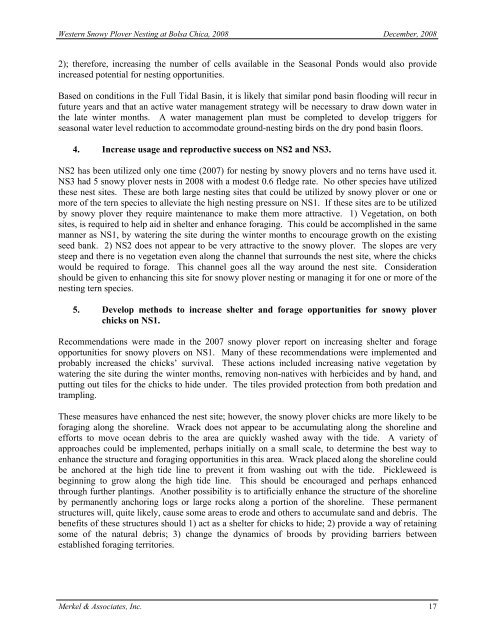2008 Annual Monitoring Report (pdf 10.9MB) - Bolsa Chica ...
2008 Annual Monitoring Report (pdf 10.9MB) - Bolsa Chica ...
2008 Annual Monitoring Report (pdf 10.9MB) - Bolsa Chica ...
Create successful ePaper yourself
Turn your PDF publications into a flip-book with our unique Google optimized e-Paper software.
Western Snowy Plover Nesting at <strong>Bolsa</strong> <strong>Chica</strong>, <strong>2008</strong> December, <strong>2008</strong><br />
2); therefore, increasing the number of cells available in the Seasonal Ponds would also provide<br />
increased potential for nesting opportunities.<br />
Based on conditions in the Full Tidal Basin, it is likely that similar pond basin flooding will recur in<br />
future years and that an active water management strategy will be necessary to draw down water in<br />
the late winter months. A water management plan must be completed to develop triggers for<br />
seasonal water level reduction to accommodate ground-nesting birds on the dry pond basin floors.<br />
4. Increase usage and reproductive success on NS2 and NS3.<br />
NS2 has been utilized only one time (2007) for nesting by snowy plovers and no terns have used it.<br />
NS3 had 5 snowy plover nests in <strong>2008</strong> with a modest 0.6 fledge rate. No other species have utilized<br />
these nest sites. These are both large nesting sites that could be utilized by snowy plover or one or<br />
more of the tern species to alleviate the high nesting pressure on NS1. If these sites are to be utilized<br />
by snowy plover they require maintenance to make them more attractive. 1) Vegetation, on both<br />
sites, is required to help aid in shelter and enhance foraging. This could be accomplished in the same<br />
manner as NS1, by watering the site during the winter months to encourage growth on the existing<br />
seed bank. 2) NS2 does not appear to be very attractive to the snowy plover. The slopes are very<br />
steep and there is no vegetation even along the channel that surrounds the nest site, where the chicks<br />
would be required to forage. This channel goes all the way around the nest site. Consideration<br />
should be given to enhancing this site for snowy plover nesting or managing it for one or more of the<br />
nesting tern species.<br />
5. Develop methods to increase shelter and forage opportunities for snowy plover<br />
chicks on NS1.<br />
Recommendations were made in the 2007 snowy plover report on increasing shelter and forage<br />
opportunities for snowy plovers on NS1. Many of these recommendations were implemented and<br />
probably increased the chicks’ survival. These actions included increasing native vegetation by<br />
watering the site during the winter months, removing non-natives with herbicides and by hand, and<br />
putting out tiles for the chicks to hide under. The tiles provided protection from both predation and<br />
trampling.<br />
These measures have enhanced the nest site; however, the snowy plover chicks are more likely to be<br />
foraging along the shoreline. Wrack does not appear to be accumulating along the shoreline and<br />
efforts to move ocean debris to the area are quickly washed away with the tide. A variety of<br />
approaches could be implemented, perhaps initially on a small scale, to determine the best way to<br />
enhance the structure and foraging opportunities in this area. Wrack placed along the shoreline could<br />
be anchored at the high tide line to prevent it from washing out with the tide. Pickleweed is<br />
beginning to grow along the high tide line. This should be encouraged and perhaps enhanced<br />
through further plantings. Another possibility is to artificially enhance the structure of the shoreline<br />
by permanently anchoring logs or large rocks along a portion of the shoreline. These permanent<br />
structures will, quite likely, cause some areas to erode and others to accumulate sand and debris. The<br />
benefits of these structures should 1) act as a shelter for chicks to hide; 2) provide a way of retaining<br />
some of the natural debris; 3) change the dynamics of broods by providing barriers between<br />
established foraging territories.<br />
Merkel & Associates, Inc. 17






